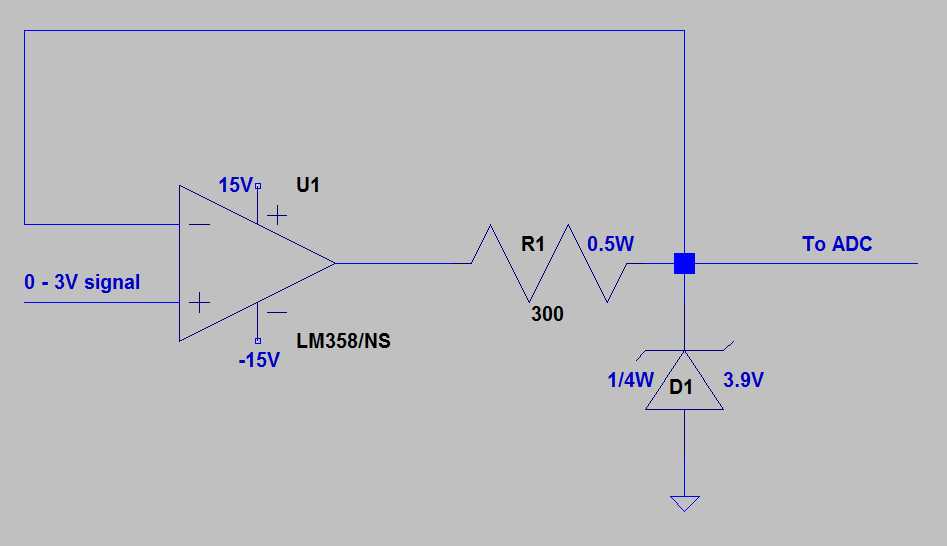Post History
Here is a solution to protects very well the ADC from over-voltage spikes, avoid any simulation and design consideration, and that also protects the ADC from a possible negative output spike from t...
#4: Post edited
- Here is a solution to protects very well the ADC from over-voltage spikes, avoid any simulation and design consideration, and that also protects the ADC from a possible negative output spike from the op-amp output at startup.
- 
- For high frequencies, it may be necessary to put a "compensation capacitor" as explained in the answer of Olin.
- > Or just Shottky diodes to ground and the A/D supply. The Shottkys should kick in before the protection circuitry of the A/D. With a normal silicon junction drop, the internal protection circuitry might take most of the load.
- The problem is that we know nothing about this ADC device. So, I consider it as a device sensitive to over-voltage, that may or may not have a protection circuitry against negative input voltage.
Now, if it has no protection, the zener, with its 0.6V forward voltage should be sufficient in most cases (otherwise a Schottky may be connected in parallel as suggested by Olin). But if the ADC device has a negative input voltage protection, then even if it takes most of the load, it will dissipate at most 15*15/300 = 0.75W. I can hardly imagine a protection circuitry that is not able to dissipate this power.
- Here is a solution to protects very well the ADC from over-voltage spikes, avoid any simulation and design consideration, and that also protects the ADC from a possible negative output spike from the op-amp output at startup.
- 
- For high frequencies, it may be necessary to put a "compensation capacitor" as explained in the answer of Olin.
- > Or just Shottky diodes to ground and the A/D supply. The Shottkys should kick in before the protection circuitry of the A/D. With a normal silicon junction drop, the internal protection circuitry might take most of the load.
- The problem is that we know nothing about this ADC device. So, I consider it as a device sensitive to over-voltage, that may or may not have a protection circuitry against negative input voltage.
- Now, if it has no protection, the zener, with its 0.6V forward voltage should be sufficient in most cases (otherwise a Schottky may be connected in parallel as suggested by Olin). But if the ADC device has a negative input voltage protection, then even if it takes most of the load, it will dissipate at most 0.6 * 15/300 = 0.03 W. I can hardly imagine a protection circuitry that is not able to dissipate this power.
#3: Post edited
- Here is a solution to protects very well the ADC from over-voltage spikes, avoid any simulation and design consideration, and that also protects the ADC from a possible negative output spike from the op-amp output at startup.
- 
For high frequencies, it may be necessary to put a "compensation capacitor" as explained in the answer of Olin.
- Here is a solution to protects very well the ADC from over-voltage spikes, avoid any simulation and design consideration, and that also protects the ADC from a possible negative output spike from the op-amp output at startup.
- 
- For high frequencies, it may be necessary to put a "compensation capacitor" as explained in the answer of Olin.
- > Or just Shottky diodes to ground and the A/D supply. The Shottkys should kick in before the protection circuitry of the A/D. With a normal silicon junction drop, the internal protection circuitry might take most of the load.
- The problem is that we know nothing about this ADC device. So, I consider it as a device sensitive to over-voltage, that may or may not have a protection circuitry against negative input voltage.
- Now, if it has no protection, the zener, with its 0.6V forward voltage should be sufficient in most cases (otherwise a Schottky may be connected in parallel as suggested by Olin). But if the ADC device has a negative input voltage protection, then even if it takes most of the load, it will dissipate at most 15*15/300 = 0.75W. I can hardly imagine a protection circuitry that is not able to dissipate this power.
#2: Post edited
- Here is a solution to protects very well the ADC from over-voltage spikes, avoid any simulation and design consideration, and that also protects the ADC from a possible negative output spike from the op-amp output at startup.

- Here is a solution to protects very well the ADC from over-voltage spikes, avoid any simulation and design consideration, and that also protects the ADC from a possible negative output spike from the op-amp output at startup.
- 
- For high frequencies, it may be necessary to put a "compensation capacitor" as explained in the answer of Olin.
#1: Initial revision
Here is a solution to protects very well the ADC from over-voltage spikes, avoid any simulation and design consideration, and that also protects the ADC from a possible negative output spike from the op-amp output at startup. 


















